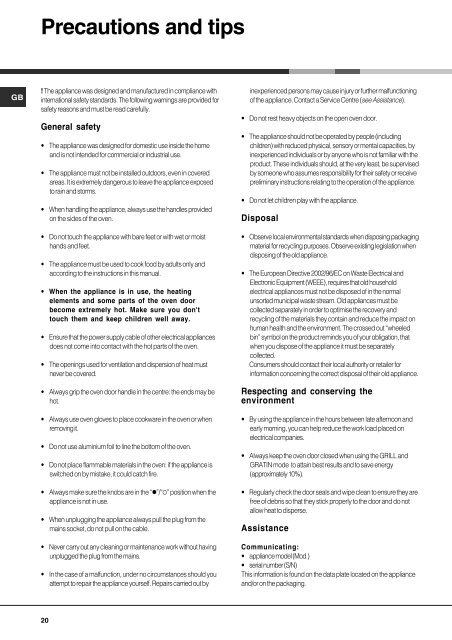KitchenAid F 53 C.1 IX /HA - Oven - F 53 C.1 IX /HA - Oven PT (F053971) Istruzioni per l'Uso
KitchenAid F 53 C.1 IX /HA - Oven - F 53 C.1 IX /HA - Oven PT (F053971) Istruzioni per l'Uso
KitchenAid F 53 C.1 IX /HA - Oven - F 53 C.1 IX /HA - Oven PT (F053971) Istruzioni per l'Uso
You also want an ePaper? Increase the reach of your titles
YUMPU automatically turns print PDFs into web optimized ePapers that Google loves.
Precautions and tips<br />
GB<br />
! The appliance was designed and manufactured in compliance with<br />
international safety standards. The following warnings are provided for<br />
safety reasons and must be read carefully.<br />
General safety<br />
• The appliance was designed for domestic use inside the home<br />
and is not intended for commercial or industrial use.<br />
• The appliance must not be installed outdoors, even in covered<br />
areas. It is extremely dangerous to leave the appliance exposed<br />
to rain and storms.<br />
• When handling the appliance, always use the handles provided<br />
on the sides of the oven.<br />
• Do not touch the appliance with bare feet or with wet or moist<br />
hands and feet.<br />
• The appliance must be used to cook food by adults only and<br />
according to the instructions in this manual.<br />
• When the appliance is in use, the heating<br />
elements and some parts of the oven door<br />
become extremely hot. Make sure you don't<br />
touch them and keep children well away.<br />
• Ensure that the power supply cable of other electrical appliances<br />
does not come into contact with the hot parts of the oven.<br />
• The openings used for ventilation and dis<strong>per</strong>sion of heat must<br />
never be covered.<br />
• Always grip the oven door handle in the centre: the ends may be<br />
hot.<br />
• Always use oven gloves to place cookware in the oven or when<br />
removing it.<br />
• Do not use aluminium foil to line the bottom of the oven.<br />
• Do not place flammable materials in the oven: if the appliance is<br />
switched on by mistake, it could catch fire.<br />
• Always make sure the knobs are in the “!”/“"” position when the<br />
appliance is not in use.<br />
• When unplugging the appliance always pull the plug from the<br />
mains socket, do not pull on the cable.<br />
• Never carry out any cleaning or maintenance work without having<br />
unplugged the plug from the mains.<br />
• In the case of a malfunction, under no circumstances should you<br />
attempt to repair the appliance yourself. Repairs carried out by<br />
inex<strong>per</strong>ienced <strong>per</strong>sons may cause injury or further malfunctioning<br />
of the appliance. Contact a Service Centre (see Assistance).<br />
• Do not rest heavy objects on the open oven door.<br />
• The appliance should not be o<strong>per</strong>ated by people (including<br />
children) with reduced physical, sensory or mental capacities, by<br />
inex<strong>per</strong>ienced individuals or by anyone who is not familiar with the<br />
product. These individuals should, at the very least, be su<strong>per</strong>vised<br />
by someone who assumes responsibility for their safety or receive<br />
preliminary instructions relating to the o<strong>per</strong>ation of the appliance.<br />
• Do not let children play with the appliance.<br />
Disposal<br />
• Observe local environmental standards when disposing packaging<br />
material for recycling purposes. Observe existing legislation when<br />
disposing of the old appliance.<br />
• The European Directive 2002/96/EC on Waste Electrical and<br />
Electronic Equipment (WEEE), requires that old household<br />
electrical appliances must not be disposed of in the normal<br />
unsorted municipal waste stream. Old appliances must be<br />
collected separately in order to optimise the recovery and<br />
recycling of the materials they contain and reduce the impact on<br />
human health and the environment. The crossed out “wheeled<br />
bin” symbol on the product reminds you of your obligation, that<br />
when you dispose of the appliance it must be separately<br />
collected.<br />
Consumers should contact their local authority or retailer for<br />
information concerning the correct disposal of their old appliance.<br />
Respecting and conserving the<br />
environment<br />
• By using the appliance in the hours between late afternoon and<br />
early morning, you can help reduce the work load placed on<br />
electrical companies.<br />
• Always keep the oven door closed when using the GRILL and<br />
GRATIN mode to attain best results and to save energy<br />
(approximately 10%).<br />
• Regularly check the door seals and wipe clean to ensure they are<br />
free of debris so that they stick pro<strong>per</strong>ly to the door and do not<br />
allow heat to dis<strong>per</strong>se.<br />
Assistance<br />
Communicating:<br />
• appliance model (Mod.)<br />
• serial number (S/N)<br />
This information is found on the data plate located on the appliance<br />
and/or on the packaging.<br />
20
















